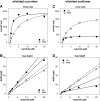Degradation of lipoxygenase-derived oxylipins by glyoxysomes from sunflower and cucumber cotyledons
- PMID: 24207097
- PMCID: PMC3831820
- DOI: 10.1186/1471-2229-13-177
Degradation of lipoxygenase-derived oxylipins by glyoxysomes from sunflower and cucumber cotyledons
Abstract
Background: Oilseed germination is characterized by the degradation of storage lipids. It may proceed either via the direct action of a triacylglycerol lipase, or in certain plant species via a specific lipid body 13-lipoxygenase. For the involvement of a lipoxygenase previous results suggested that the hydroxy- or oxo-group that is being introduced into the fatty acid backbone by this lipoxygenase forms a barrier to continuous β-oxidation.
Results: This study shows however that a complete degradation of oxygenated fatty acids is possible by isolated cucumber and sunflower glyoxysomes. Interestingly, degradation is accompanied by the formation of saturated short chain acyl-CoAs with chain length between 4 and 12 carbon atoms lacking the hydroxy- or oxo-diene system of the oxygenated fatty acid substrate. The presence of these CoA esters suggests the involvement of a specific reduction of the diene system at a chain length of 12 carbon atoms including conversion of the hydroxy-group at C7.
Conclusions: To our knowledge this metabolic pathway has not been described for the degradation of polyunsaturated fatty acids so far. It may represent a new principle to degrade oxygenated fatty acid derivatives formed by lipoxygenases or chemical oxidation initiated by reactive oxygen species.
Figures





References
-
- Biermann U, Friedt W, Lang S, Lühs W, Machmüller G, Metzger JO, Rüsch gen, Klaas M, Schäfer HJ, Schneider MP. New syntheses with oils and fats as renewable raw materials for the chemical industry. Angew Chem Int Ed Engl. 2000;39(13):2206–2224. doi: 10.1002/1521-3773(20000703)39:13<2206::AID-ANIE2206>3.0.CO;2-P. - DOI - PubMed
Publication types
MeSH terms
Substances
LinkOut - more resources
Full Text Sources
Other Literature Sources
Molecular Biology Databases
Miscellaneous

